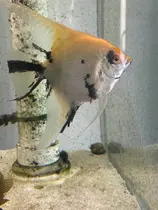Camallanus Worms
Camallanus Worms are one of the most commonly found internal parasites that infect fish ranging from aquarium fish to even fish that are inside of a pond. Many may think that the fish that is infected is pregnant or giving birth to either live fry or eggs due to the way that their anus may appear when infected. Sadly, due to the way that this parasite infects its host fish and lacks the understanding that the fish can not only become very ill but if not treated, the parasite can prove to be fatal to the infected fish.
Identification
The most common identification of this worm infecting a fish is the presence of red thread-like worms that are hanging out of the fish's anus. The other symptoms that the fish can display include bloating of the stomach area, the dull coloration of the fish, staying in one area of the tank, and being lethargic. Some species can show no symptoms of the infection besides the worm hanging from the anus, while others may show all visible signs of infection depending on the conditions of the water that they are in.
Pathology
To understand how to treat and remove the camallanus worm completely, we must first understand how the camallanus worms live and reproduce. The camallanus worms must go through three different stages before they can infect fish that are within their water column. We will start with the free-living stage (it's the first stage) to provide a better understanding. The larvae will settle out onto the bottom of the substrate where they will start to wiggle around and try to prove as food to crustaceans. Once eaten by a crustacean, it will stay within the infected crustacean while it grows and mature into its next stage. Within a timeframe of about a week, they will start to molt multiple times and become slightly dormant waiting for a fish to eat the crustacean. If the crustacean is never eaten and dies due to its natural lifespan ending, the final stage will never take place and the dormant camallanus worm will die due to a lack of food from a host. However, if the crustacean is eaten then the camallanus worm will become active again as it passes through the internal organs of the fish.
The familiar red worm that is near the anus of the fish is an active, sexually mature male or female trying to find another infected fish in which the worm can mate and produce the larvae all over again. If the worm can find another worm that is of the opposite sex, the larvae will produce and attach to the fish's waste to repeat the life cycle all over again.
Treatment and Medications
Since this worm is the most common parasite that can infect fish, it has multiple different types of treatments that are known to work and kill off the parasite in different manners. The first set is fenbendazole, levamisole, and praziquantel which instead of killing the parasite off will just paralyze them making them unable to mate or stay attached to the fish and become pushed out by the fish's waste. Within 24 hours the substrate should be thoroughly cleaned and rinsed off using any of these medications to prevent the worms from infecting the fish again.
Antihelminthic medications are highly toxic to both snails and shrimp, and they must be removed before treatment to prevent the death of them. This medicine is also toxic to fish if used incorrectly such as at a higher dosage rate than stated on the bottle but is highly effective at killing the parasite. This is the most common medicine to be used when treating any type of delicate fish that is infected since it has such as high rate of success when used in treating the whole water column that is infected. If you treat only the given infected fish inside of a quarantine tank, other fish may already be infected and not show signs in the main tank where the fish was found to be infected.


